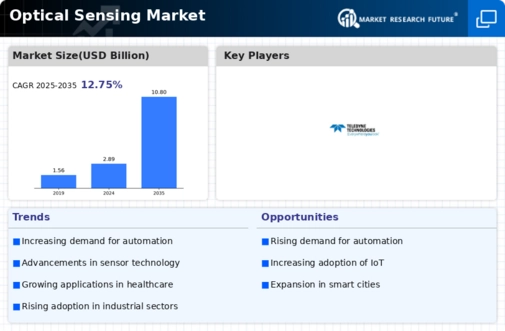Top Industry Leaders in the Optical Sensing Market

*Disclaimer: List of key companies in no particular order
Competitive Landscape of the Optical Sensing Market:
The optical sensing market is experiencing a dynamic growth trajectory fueled by diverse applications across industries. This burgeoning landscape is characterized by a vibrant mix of established players, innovative startups, and strategic acquisitions, creating a complex and ever-evolving competitive scenario. To navigate this landscape effectively, understanding the key players' strategies, market share dynamics, and emerging trends is crucial.
Some of the Optical sensing companies listed below:
- Oxsensis Ltd
- E. Connectivity Ltd.
- AMS AG.
- ABB Ltd.
- Texas Instrument Incorporated
- Infineon Technologies AG.
- Sony Corporation
- ROHM Company Ltd
- Hamamatsu Photonics K.K.
- Analog Devices Inc.
Factors Influencing Market Share Analysis:
- Product Portfolio Breadth and Depth: Offering a diverse range of sensors catering to various applications and industries is crucial. Companies with comprehensive portfolios, like Omron and TE Connectivity, hold an advantage over those with limited offerings.
- Technological Advancements: Continuous innovation in sensor technologies like miniaturization, low-power consumption, and increased accuracy is critical for market success. Companies like STMicroelectronics with their focus on micro-mirrors and integrated optics are leading the way in this aspect.
- Vertical Market Penetration: Establishing strong relationships and understanding the specific needs of key industries like automotive, healthcare, and consumer electronics is essential. Companies like Infineon Technologies, with their expertise in automotive sensors, have carved a niche in this sector.
- Pricing and Cost Efficiency: Maintaining competitive pricing while delivering high-quality sensors is crucial for market penetration. Companies like Melexis and Vishay Intertechnology excel at offering cost-effective solutions for mass-market applications.
New and Emerging Companies:
The influx of startups is shaping the competitive landscape with disruptive innovations and agile approaches. Some noteworthy examples include:
- Vigo Systems: Developing ultra-high-resolution LiDAR sensors for autonomous vehicles.
- Silex: Pioneering CMOS image sensors with enhanced low-light performance for security and surveillance applications.
- Movantics: Specializing in micro-optical sensors for wearables and medical devices.
These startups are attracting significant investments and strategic partnerships, potentially challenging established players in specific segments.
Latest Company Updates:
In 2023- Asus launched the WT300, a brand-new wireless optical mouse, to broaden its product line in India. An optical sensor with a 1600 dpi resolution is combined with an ambidextrous design in this new mouse. The mouse is portable and lightweight.
An electro-optical sensor and information system that enables users to optimise fertiliser usage based on ongoing and easily accessible soil data will be made available in 2023 by the Israeli start-up DOTS (Data Of The Soil). This technology could have a significant impact on global agriculture, sustainability, and the health of the global population.
The "NEC Intelligent Optical Fibre Sensing Solution," which enables Communications Service Providers (CSP) and optical fibre owners from all over the world to use optical fibre as a sensor, will go on sale in 2021, according to a statement released by NEC Corporation today. By analysing vibrations picked up by optical fibres using AI, this technology aids in the maintenance of infrastructure by enabling the early diagnosis of anomalies such fibre degradation and assisting in the mitigation of further damage.
